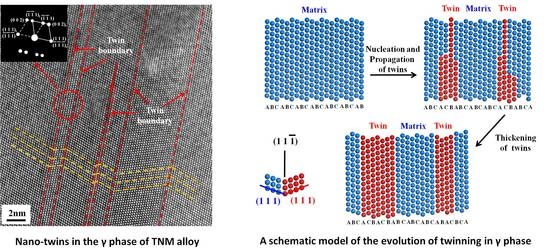Nanoscale Twinned Ti-44Al-4Nb-1.5Mo-0.007Y Alloy Promoted by High Temperature Compression with High Strain Rate
Abstract
:1. Introduction
2. Materials and Methods
3. Results
4. Discussion
5. Conclusions
Author Contributions
Funding
Conflicts of Interest
References
- Wei, D.X.; Koizumi, Y.; Nagasako, M.; Chiba, A. Refinement of lamellar structures in Ti-Al alloy. Acta Mater. 2017, 125, 81–97. [Google Scholar] [CrossRef]
- Bartels, A.; Clemens, H.; Dehm, G.; Lach, E.; Schillinger, W. Strain Rate Dependence of the Deformation Mechanisms in a Fully Lamellar γ-TiAl-Based Alloy. Zeitschrift für Metallkunde 2002, 93, 180–185. [Google Scholar] [CrossRef]
- Erdely, P.; Staron, P.; Maawad, E. Effect of hot rolling and primary annealing on the microstructure and texture of a β-stabilised γ-TiAl based alloy. Acta Mater. 2017, 126, 145–153. [Google Scholar] [CrossRef]
- Wang, Q.; Ding, H.S.; Zhang, H. Influence of Mn addition on the microstructure and mechanical properties of a directionally solidified γ-TiAl alloy. Mater. Charact. 2018, 137, 133–141. [Google Scholar] [CrossRef]
- Vajpai, S.K.; Ameyama, K. A novel powder metallurgy processing approach to prepare fine-grained Ti-rich TiAl-based alloys from pre-alloyed powders. Intermetallics 2013, 42, 146–155. [Google Scholar] [CrossRef]
- Draper, S.L.; Krause, D.; Lerch, B. Development and evaluation of TiAl sheet structures for hypersonic applications. Mater. Sci. Eng. A 2007, 464, 330–342. [Google Scholar] [CrossRef] [Green Version]
- Clemens, H.; Kestler, H. Processing and Applications of Intermetallic γ-TiAl-Based Alloys. Adv. Eng. Mater. 2000, 2, 551–570. [Google Scholar] [CrossRef]
- Clemens, H.; Mayer, S. Design, Processing, Microstructure, Properties, and Applications of Advanced Intermetallic TiAl Alloys. Adv. Eng. Mater. 2013, 15, 191–215. [Google Scholar] [CrossRef]
- Liang, X.; Liu, Y.; Li, H.; Gan, Z. An investigation on microstructural and mechanical properties of powder metallurgical TiAl alloy during hot pack-rolling. Mater. Sci. Eng. A 2014, 619, 265–273. [Google Scholar] [CrossRef]
- Monchoux, J.P.; Luo, J.S.; Voisin, T. Deformation modes and size effect in near-γ TiAl alloys. Mater. Sci. Eng. A 2017, 679, 123–132. [Google Scholar] [CrossRef]
- Cheng, L.; Li, J.S.; Xue, X.Y. Superplastic deformation mechanisms of high Nb containing TiAl alloy with (α2 + γ) microstructure. Intermetallics 2016, 75, 62–71. [Google Scholar] [CrossRef]
- Cao, G.H.; Russell, A.M.; Oertel, C.-G. Microstructural evolution of TiAl-based alloys deformed by high-pressure torsion. Acta Mater. 2015, 98, 103–112. [Google Scholar] [CrossRef]
- Chen, G.L.; Zhang, L.C. Deformation mechanism at large strains in a high-Nb-containing TiAL at room temperature. Mater. Sci. Eng. A 2002, 329, 163–170. [Google Scholar] [CrossRef]
- Rackel, M.W.; Stark, A.; Gabrisch, H. Orthorhombic phase formation in a Nb-rich γ-TiAl based alloy—An in situ synchrotron radiation investigation. Acta Mater. 2016, 121, 343–351. [Google Scholar] [CrossRef]
- Jiang, H.T.; Tian, S.W.; Guo, W.Q. Hot deformation behavior and deformation mechanism of two TiAl-Mo alloys during hot compression. Mater. Sci. Eng. A 2018, 719, 104–111. [Google Scholar] [CrossRef]
- Jiang, H.T.; Zeng, S.W.; Zhao, A.M. Hot deformation behavior of β phase containing γ-TiAl alloy. Mater. Sci. Eng. A 2016, 661, 160–167. [Google Scholar] [CrossRef]
- Niu, H.Z.; Chen, Y.Y.; Xiao, S.L. High temperature deformation behaviors of Ti-45Al-2Nb-1.5V-1Mo-Y alloy. Intermetallics 2011, 19, 1767–1774. [Google Scholar] [CrossRef]
- Wang, G.; Xu, L.; Tian, Y.X. Flow behavior and microstructure evolution of a P/M TiAl alloy during high temperature deformation. Mater. Sci. Eng. A 2011, 528, 6754–6763. [Google Scholar] [CrossRef]
- Kothari, K.; Radhakrishnan, R.; Wereley, N.M. Advances in gamma titanium aluminides and their manufacturing techniques. Prog. Aerosp. Sci. 2012, 55, 1–16. [Google Scholar] [CrossRef]
- Hao, Y.J.; Liu, J.X.; Li, J.C. Investigation on dynamic properties and failure mechanisms of Ti–47Al–2Cr–2Nb alloy under uniaxial dynamic compression at a temperature range of 288 K–773 K. J. Alloys Compd. 2015, 649, 122–127. [Google Scholar]
- Maloy, S.A.; Gray, G.T., III. High strain rate deformation of Ti–48Al–2Nb–2Cr. Acta Mater. 1996, 44, 1741–1756. [Google Scholar] [CrossRef]
- Zan, X.; Wang, Y.; Xia, Y.M. Strain rate effect on the tensile behavior of Duplex Ti–46.5Al–2Nb–2Cr intermetallics at elevated temperatures. Mater. Sci. Eng. A 2008, 498, 296–301. [Google Scholar] [CrossRef]
- Wang, L.; Wang, Y.C.; Zhilyaev, A.P.; Korznikov, A.V.; Li, S.K.; Korznikova, E.; Langdon, T.G. Dynamic compressive behavior of ultrafine-grained pure Ti at elevated temperatures after processing by ECAP. J. Mater. Sci. 2014, 49, 6640–6647. [Google Scholar] [CrossRef]
- Chen, G.; Peng, Y.B.; Zheng, G. Polysynthetic twinned TiAl single crystals for high-temperature applications. Nat. Mater. 2016, 15, 876–882. [Google Scholar] [CrossRef] [PubMed]
- Dumitraschkewitz, P.; Clemens, H.; Mayer, S.; Holec, D. Impact of Alloying on Stacking Fault Energies in γ-TiAl. Appl. Sci. 2017, 7, 1193. [Google Scholar] [CrossRef]





© 2018 by the authors. Licensee MDPI, Basel, Switzerland. This article is an open access article distributed under the terms and conditions of the Creative Commons Attribution (CC BY) license (http://creativecommons.org/licenses/by/4.0/).
Share and Cite
Guo, W.; Jiang, H.; Tian, S.; Zhang, G. Nanoscale Twinned Ti-44Al-4Nb-1.5Mo-0.007Y Alloy Promoted by High Temperature Compression with High Strain Rate. Metals 2018, 8, 619. https://doi.org/10.3390/met8080619
Guo W, Jiang H, Tian S, Zhang G. Nanoscale Twinned Ti-44Al-4Nb-1.5Mo-0.007Y Alloy Promoted by High Temperature Compression with High Strain Rate. Metals. 2018; 8(8):619. https://doi.org/10.3390/met8080619
Chicago/Turabian StyleGuo, Wenqi, Haitao Jiang, Shiwei Tian, and Guihua Zhang. 2018. "Nanoscale Twinned Ti-44Al-4Nb-1.5Mo-0.007Y Alloy Promoted by High Temperature Compression with High Strain Rate" Metals 8, no. 8: 619. https://doi.org/10.3390/met8080619




